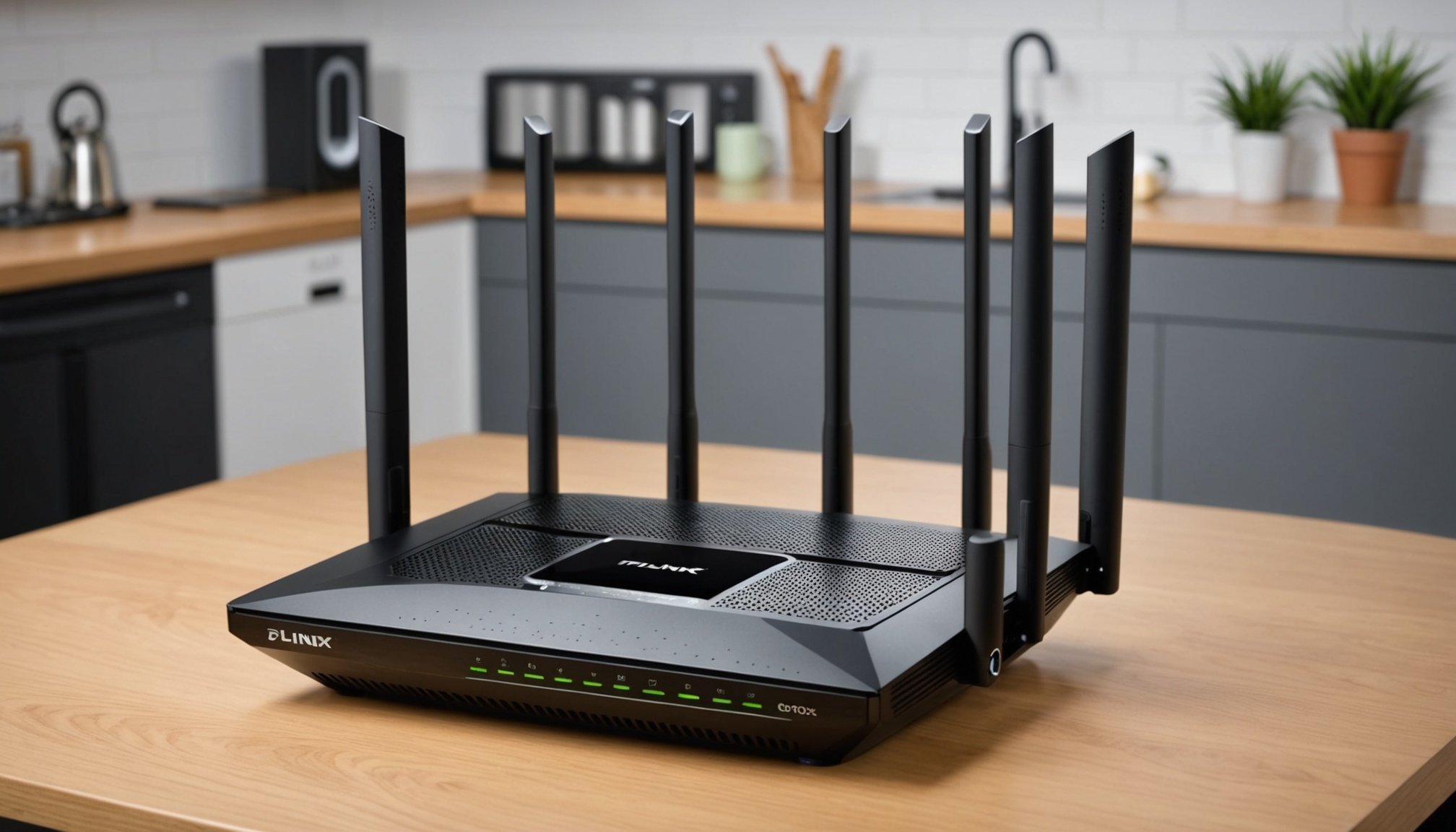Building a Safe Wi-Fi Network at Home with the TP-Link Archer C5400X: Top Tips and Best Practices
Understanding the TP-Link Archer C5400X
Before we dive into the tips for building a safe Wi-Fi network, it’s essential to understand the capabilities and potential vulnerabilities of the TP-Link Archer C5400X. This router is a high-end gaming router known for its robust performance, featuring Wi-Fi 6 (802.11ax) technology, a tri-band setup, and MU-MIMO (Multi-User Multiple Input Multiple Output) support. Here are some key features:
- Tri-Band Wi-Fi: The Archer C5400X offers three separate bands (one 2.4GHz and two 5GHz) to reduce congestion and ensure stable connections.
- MU-MIMO: This technology allows the router to serve multiple devices simultaneously, enhancing overall network performance.
- Gigabit Ethernet Ports: With eight Gigabit Ethernet ports, you can connect multiple devices via wired connections for added security and speed.
- Advanced Security Features: The router comes with built-in security features such as WPA3 encryption and a built-in antivirus.
Setting Up Your Router Securely
Setting up your router securely is the first step in building a safe Wi-Fi network.
Have you seen this : Mastering Overclocking on ASUS ROG Crosshair VIII Hero: The Definitive Liquid Cooling Handbook
Changing Default Settings
One of the most critical steps is to change the default settings of your router. Here’s why:
- Default Passwords: Default passwords are often easily guessable and can be found online. Changing them immediately protects your network from unauthorized access.
- Default Network Name (SSID): Changing the default SSID makes it harder for hackers to identify your router model and exploit known vulnerabilities.
### Steps to Change Default Settings:
- Log into the web interface of your router (usually by typing the router's IP address in your browser).
- Change the admin password and username.
- Update the SSID and set a strong password for your Wi-Fi network.
Updating Firmware
Keeping your router’s firmware up-to-date is crucial for patching security vulnerabilities.
Also to read : Ultimate NZXT H710i Liquid Cooling Installation: Boost Your System’s Thermal Performance with These Easy Steps
### Why Update Firmware?
- Fixes known vulnerabilities: Regular updates often include patches for security flaws discovered in the router’s software.
- Improves performance: Updates can enhance the overall performance and stability of your network.
- Adds new features: New firmware versions may include additional security features or improvements.
### How to Update Firmware:
- Check the TP-Link website for the latest firmware version.
- Download the update file.
- Log into the web interface of your router.
- Navigate to the firmware update section and upload the new firmware file.
Enhancing Network Security
Using Strong Encryption
Ensure that your network uses the latest encryption standards.
### WPA3 Encryption:
- WPA3 is the latest and most secure encryption protocol available.
- It provides better protection against brute-force attacks and other forms of unauthorized access.
- Enable WPA3 in the wireless settings section of your router’s web interface.
Implementing a Guest Network
Setting up a guest network can help isolate visitors from your main network.
### Benefits of a Guest Network:
- Segregates visitors: Keeps guests from accessing your main network, reducing the risk of malware and unauthorized access.
- Easy to set up: Most modern routers, including the Archer C5400X, have a simple setup process for guest networks.
### How to Set Up a Guest Network:
- Log into the web interface of your router.
- Navigate to the guest network settings.
- Enable the guest network and set a strong password.
- Configure any additional settings, such as bandwidth limits or access restrictions.
Using a VPN
Consider using a VPN (Virtual Private Network) to add an extra layer of security, especially when accessing the internet via public Wi-Fi.
### Why Use a VPN?
- Encrypts internet traffic: Protects your data from being intercepted by hackers.
- Masks IP address: Helps in maintaining anonymity online.
### How to Set Up a VPN:
- Choose a reputable VPN service.
- Install the VPN client on your devices.
- Connect to the VPN whenever you access the internet, especially on public networks.
Addressing Known Vulnerabilities
The TP-Link Archer C5400X, like many other routers, has faced some security vulnerabilities in the past. Here are some tips to address these issues:
Remote Command Execution Vulnerability
In May 2024, a critical vulnerability was discovered in the TP-Link Archer C5400X that allowed remote command execution. Here’s how to mitigate this:
### Mitigating Remote Command Execution:
- Ensure your router’s firmware is updated to the latest version.
- Disable any unnecessary services or ports that could be exploited.
- Use a network scanner like nmap to check for open ports on your router.
### Example:
- A security advisory from OneKey highlighted that the vulnerability exposes a network listener on TCP ports 8888, 8889, and 8890. Updating the firmware and disabling these ports can prevent exploitation.
Other Security Flaws
Other routers, including those from Asus and D-Link, have also faced significant security issues. Here’s a comparison of some common vulnerabilities:
| Router Model | Vulnerability | Mitigation |
|---|---|---|
| TP-Link Archer C5400X | Remote Command Execution via TCP ports 8888, 8889, 8890 | Update firmware, disable unnecessary services/ports |
| Asus XT8 | Authentication bypass flaw (CVE-2024-3080) | Update firmware, ensure strong passwords and enable WPA3 encryption |
| D-Link DIR-846W | Multiple RCE flaws | Avoid using this model; if already in use, consider replacing it |
| Netgear RAX30 | JSON Parsing getblockschedule() stack-based buffer overflow vulnerability | Update firmware, use strong passwords and enable WPA3 encryption |
Best Practices for Daily Use
Regularly Monitoring Your Network
Keep an eye on your network activity to detect any unusual behavior.
### How to Monitor Your Network:
- Use the router’s built-in monitoring tools to check for connected devices.
- Set up alerts for unusual network activity.
- Regularly review your network logs.
Using Strong Passwords
Strong passwords are your first line of defense against unauthorized access.
### Tips for Strong Passwords:
- Use a mix of uppercase and lowercase letters, numbers, and special characters.
- Avoid using easily guessable information such as names or birthdays.
- Change passwords periodically.
Securing IoT Devices
Internet of Things (IoT) devices can be a weak link in your network security.
### Securing IoT Devices:
- Change default passwords on IoT devices.
- Keep IoT devices updated with the latest firmware.
- Isolate IoT devices on a separate network if possible.
Building a safe Wi-Fi network at home with the TP-Link Archer C5400X requires a combination of proper setup, regular maintenance, and awareness of potential vulnerabilities. Here are some final tips:
- Stay Informed: Keep up-to-date with the latest security advisories and firmware updates.
- Use Advanced Security Features: Leverage features like WPA3 encryption, guest networks, and VPNs to enhance your network’s security.
- Regular Maintenance: Regularly update your router’s firmware, monitor your network, and use strong passwords.
By following these tips, you can ensure a secure and reliable home network that protects your devices and data from potential threats.
Additional Resources
For more detailed information on securing your router and network, here are some additional resources:
- TP-Link Support: The official TP-Link support website provides detailed guides and updates for their routers.
- Router Security.org: This website offers comprehensive information on router vulnerabilities and security best practices.
- Cybersecurity Blogs: Websites like Bleeping Computer and Krebs on Security provide up-to-date information on cybersecurity threats and how to mitigate them.
By being proactive and informed, you can enjoy a safe and secure Wi-Fi network at home.











